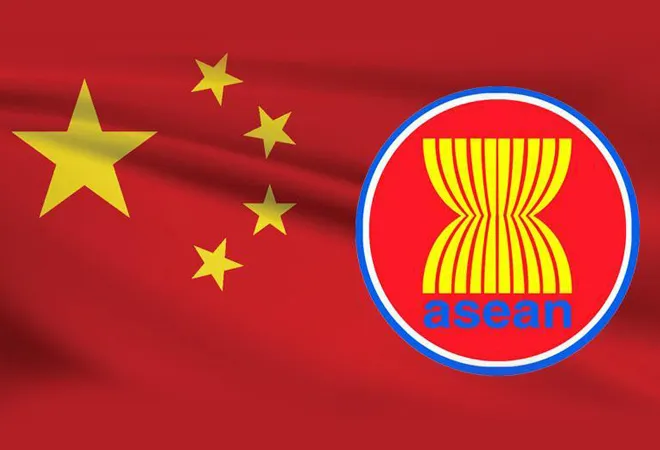
China and ASEAN held a special summit to commemorate the 30th anniversary of their dialogue partnership (DP) on 22 November 2021. It was co-chaired by the Sultan of Brunei, and the Chinese President, Xi Jinping. It elevated the relationship to a comprehensive strategic partnership. The event was held virtually even though the 30th anniversary Foreign Ministers meeting was held physically in Chongqing, on 7 June.
China made every effort to bring Myanmar to the Commemorative Summit. Ultimately, the ASEAN position to keep Myanmar's leadership away from ASEAN summits till they kept their promises, prevailed.
The joint statement recognises ASEAN-China relations amongst the most dynamic and mutually beneficial partnerships for ASEAN amongst all its DPs. The relationship is guided by the Joint Statement of 1997, the Joint Declaration on the Strategic Partnership of 2003 and the vision of the strategic partnership for 2030 adopted in 2018.The preamble recognises ASEANs leading role in the regional security architecture and the inclusive principles of the ASEAN Outlook on the Indo-Pacific (AOIP). The 31-paragraph joint statement covers overall the Chinese-ASEAN relations, political-security cooperation, economic, and socio-cultural cooperation. The main takeaway is that ASEAN centrality is maintained and cooperation in the four areas identified in the AOIP is pursued.
The preamble recognises ASEANs leading role in the regional security architecture and the inclusive principles of the ASEAN Outlook on the Indo-Pacific (AOIP).
‘Mutually-beneficial cooperation with the BRI’ is included. Chinese support to the ASEAN comprehensive recovery framework is emphasised. It proposes to enhance defence exchanges A specific paragraph to preserve Southeast Asia free from nuclear weapons perhaps draws reference to AUKUS, with which some of the ASEAN countries have been uncomfortable. There is a long paragraph upholding international law, including UNCLOS. Enhancing mutual trust and maintaining peace in the SCS are reaffirmed; freedom of navigation and overflight and self-restraint in the conduct of activities without threat or use of force are written in. This is interesting because they also go on to talk about implementing the declaration on the Code of Conduct (COC) which is still in force and look forward to the early conclusion of an effective and substantive COC in accordance with the 1982 UNCLOS within a mutually agreed but undefined timeline. The open multilateral trading system, the World Trade Organisation (WTO) and the Regional Comprehensive Economic partnership (RCEP) are welcomed. China's support to the Master Plan on ASEAN Connectivity (MPAC) 2025 in correlation to the BRI is reiterated. Support from the AIIB is specifically mentioned. China's support to the COVID-related public health processes and recovery and the positive role of the ASEAN-China centre in promoting socio-cultural and P2P exchanges are appreciated.
The commitment to multilateralism and an inclusive regional framework by supporting ASEAN centrality are indeed important. Xi mentioned in his speech to abide by most of these principles and said that China would not be the neighbourhood bully or hegemonic. They will live in peace and tranquillity with their neighbours; the Philippines President complained about transgressions against their ships and territorial waters. "This does not speak well of the relations between our nations," President Duterte said.
China's support to the Master Plan on ASEAN Connectivity (MPAC) 2025 in correlation to the BRI is reiterated.
During the 30th year, China is invoking its economic capabilities to enhance the partnership while challenging the Comprehensive and Progressive Agreement for Trans-Pacific Partnership (CPTPP) which was designed to keep it out but instead the USA decided to leave! With ASEAN, it shows its policy of “Asia is where China must establish its prestige or “reputation for power.”
It is important to note the growth in China-ASEAN relations over the last 30 years. Trade increased by 80 times from US $8 billion to US $680 billion. Since 2009, China is ASEANs largest trading partner. During the pandemic, ASEAN became China’s largest partner. In 2021, trade grew by 48 percent in the first six months. At US $140 billion, the ASEAN trade is 15 percent of China’s global trade. China’s imports from Vietnam and Indonesia increased significantly manifesting the growing regional supply chains. Electronics, specially integrated circuits, contributed to the increase. China imported US $14.9 billion of ICs in 2020.
Chinese FDI into ASEAN increased 185 percent US $3.6 billion in 2010 to US $9.1 billion in 2019. This is 5.7 percent of ASEAN’s FDI inflows. In 2019, China was ASEAN’s fourth largest source of FDI, after the US, Japan, and the EU. People-to-people exchanges crossed 65 million before the pandemic, when there were nearly 4,500 weekly China-ASEAN flights. About 200 ASEAN cities have sister-city linkages with Chinese cities. 200,000 students participate in exchanges. 2017 was designated as the ASEAN-China Year of Tourism Cooperation and 2018 was the ASEAN-China Year of Innovation to enhance cooperation under the 4.0 Industrial Revolution. Similarly, 2019 was ASEAN-China Year of Media Exchanges and 2020 was designated as the ASEAN-China Year of Digital Economy Cooperation to promote digital transformation, infrastructure, AI, big data, smart cities and in using digital technologies to mitigate the impact of the COVID-19 outbreak.
2017 was designated as the ASEAN-China Year of Tourism Cooperation and 2018 was the ASEAN-China Year of Innovation to enhance cooperation under the 4.0 Industrial Revolution.
Chinese policy towards ASEAN currently can be seen working for a post pandemic world. Their ‘active cooperation and coalition building’ and ‘periphery diplomacy’ have become core policy. The world is certainly focusing on the Indo-Pacific, particularly the ASEAN. The Quad Summit Joint Statement is clear on this. The Chinese are much ahead of the curve in an organised manner. They have undertaken a broad four-pronged effort.
Priority To ASEAN
ASEAN is a priority in Chinese foreign policy. To maintain this, China promotes economic partnership with it. While prioritising ASEAN, China impresses upon them that their cooperation is practical and in mutual interest.
China is using the centenary of the founding of the Communist Party to project leadership in creating a better development matrix by opening its markets and providing economic impetus for ASEAN.
The Comprehensive Strategic Partnership would enmesh ASEAN into a stronger matrix through BRI, COC, and the 50 partnerships they have with China. While China desires inclusive approaches, all its efforts are exclusive of others. It is up to ASEAN to have openness of the region rather than let China be the determinant for its future. The ASEAN often seems allergic to challenging the Chinese hegemony as it will upset the current ‘stability’!
Spirit of partnership
Tackling major challenges in a spirit of partnership. Dealing with the pandemic of COVID-19 is the latest in the disaster management support that China has provided ASEAN. China is perceived as an effective partner in the fight against COVID and a reliable friend.
This is a gain for China, to receive such unequivocal faith from a region where it has grabbed several maritime resources including territory. It calls for Asian values to determine their relations. This allows acquiescence in coups in Thailand and Myanmar. ASEAN appears happy with the non-intrusive Chinese behaviour towards their domestic politics. For that they are often willing to sustain economic muscle flexing and rise in hidden debt.
Benefits for trade and investment
ASEAN believe that the China-ASEAN FTA and the emerging RCEP will benefit them. They don’t have apprehensions like India. ASEAN and China signed the ACFTA in 2002. They upgraded the ACFTA and developed linkages for value chains which can compete with the US and Europe. Today ASEAN countries attract RVCs related FDI for China-plus-one efforts from Quad partners too. The regional production bases that China envisages in ASEAN includes a joint production base for vaccines.
Focusing on ASEAN Comprehensive Recovery Framework, China pursues its objectives of 5G and beyond. China intends to keep ASEAN as the prime market for its digital technologies. The Quad intends to challenge this but China is quite ahead.
Focusing on ASEAN Comprehensive Recovery Framework, China pursues its objectives of 5G and beyond. China intends to keep ASEAN as the prime market for its digital technologies.
Develop mutual respect
The Chinese perception is that the aspiration of preserving regional peace and stability is shared. Despite China dragging its feet for years on the COC, ASEAN sees the situation as hopeful, rather than express frustration.
This is a marvel. Despite several ASEAN members losing island territories to China and suffering IUU in their waters, they still remain optimistic. The longer that COC discussions prolong, the more satisfied ASEAN appears to be! Contrast this with the India-China border talks.
China which is critical of the term Indo-Pacific and Quad policies, is benign in its view of the AOIP. Wang Yi told the media in 2019, after the ASEAN policy was enunciated, that it was part of regional cooperation and ‘adhering to ASEAN's core positions’. China intends to use the expectation of the COC to temper ASEAN and avoid ‘unilateral actions’ by ASEANs other partners.
Assessment
The summit seems like a shadow play, to present a unified view in light of growing global dynamics. The ASEAN-China contradictions are papered over in the hope that they would be resolved sooner or later. For the long term, ASEAN interlocutors believe that this has set a tone for the diverse China-ASEAN partnership. This could become stronger. In the medium term, there is a sense of achievement within ASEAN that China has gone along with the AOIP and its principles. This is important, since China refrains from supporting references to the Indo-Pacific.
An immediate concern to ASEAN was whether China would abide by its decision on Myanmar. Despite Chinese efforts ASEAN is satisfied that the absence of Myanmar was maintained.
The views expressed above belong to the author(s). ORF research and analyses now available on Telegram! Click here to access our curated content — blogs, longforms and interviews.




 PREV
PREV


